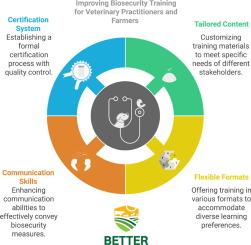兽医从业人员和农民需要接受哪些生物安全培训?
Q1 Social Sciences
引用次数: 0
摘要
有效的生物安全培训对牲畜系统的疾病预防至关重要;然而,巨大的差距仍然存在。我们结合了在线调查(74份完整填写的问卷;267个视图)与两个世界咖啡研讨会(约60名参与者)一起绘制欧洲目前的供应、能力水平和培训需求。主要发现:(i)利益相关者群体之间自评生物安全知识差异显著,兽医和其他利益相关者报告的中位数得分接近80/100;(ii)超过四分之三的牛兽医(77%)和70%的猪兽医认为,他们在向客户证明生物安全的经济效益方面存在重大差距;(iii) 39% - 44%的牛和小反刍动物兽医报告说,混合(理论+实践)培训形式不足,高达50%的家禽兽医发现在沟通和行为改变技能方面存在缺陷;(iv)在所有的讨论中,参与者都倾向于模块化、混合式交付,将简洁的电子学习与农场指导结合起来,并辅以外部审计认证和更多的农民共同设计。因此,建议的重点是开发特定品种的灵活模块,这些模块包含沟通和成本效益要素,为时间有限的农民提供微型学习单元,并在与持续专业发展相关的分层认证框架内运行。实施这些措施将缩小能力差距,加强兽医农民的参与,并在整个欧洲畜牧生产中加强疾病防范。本文章由计算机程序翻译,如有差异,请以英文原文为准。

What are desirable biosecurity trainings for veterinary practitioners and farmers?
Effective biosecurity training is essential for disease prevention in livestock systems; however, substantial gaps persist. We combined an online survey (74 fully completed questionnaires; 267 views) with two World Café workshops (∼60 participants) to map the current provision, competence levels, and training needs across Europe. Key findings: (i) self-rated biosecurity knowledge differed markedly between stakeholder groups and veterinarians and other stakeholders reported median scores close to 80/100; (ii) more than three-quarters of cattle (77 %) and 70 % of swine veterinarians perceived a major gap in their ability to demonstrate the economic benefits of biosecurity to clients; (iii) 39 – 44 % of cattle and small-ruminant veterinarians reported inadequate mixed (theory + practice) training formats, and up to 50 % of poultry veterinarians identified deficits in communication and behavior-change skills; (iv) across all discussions, participants favored modular, blended delivery that couples concise e-learning with on-farm coaching, supported by externally audited certification and greater farmer co-design. Therefore, recommendations focus on developing species-specific, flexible modules that embed communication and cost-benefit elements, provide micro-learning units for time-constrained farmers, and operate within a tiered certification framework linked to continuing professional development. Implementing these measures will narrow competence gaps, strengthen veterinarian–farmer engagement, and enhance disease preparedness throughout European livestock production.
求助全文
通过发布文献求助,成功后即可免费获取论文全文。
去求助
来源期刊

Journal of Biosafety and Biosecurity
Social Sciences-Linguistics and Language
CiteScore
6.00
自引率
0.00%
发文量
20
审稿时长
41 days
 求助内容:
求助内容: 应助结果提醒方式:
应助结果提醒方式:


